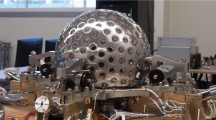Abstract
This is the first of five connected papers detailing progress on the Gravity Probe B (GP-B) Relativity Mission. GP-B, launched 20 April 2004, is a landmark physics experiment in space to test two fundamental predictions of Einstein’s general relativity theory, the geodetic and frame-dragging effects, by means of cryogenic gyroscopes in Earth orbit. Data collection began 28 August 2004 and science operations were completed 29 September 2005. The data analysis has proven deeper than expected as a result of two mutually reinforcing complications in gyroscope performance: (1) a changing polhode path affecting the calibration of the gyroscope scale factor C g against the aberration of starlight and (2) two larger than expected manifestations of a Newtonian gyro torque due to patch potentials on the rotor and housing. In earlier papers, we reported two methods, ‘geometric’ and ‘algebraic’, for identifying and removing the first Newtonian effect (‘misalignment torque’), and also a preliminary method of treating the second (‘roll-polhode resonance torque’). Central to the progress in both torque modeling and C g determination has been an extended effort on “Trapped Flux Mapping” commenced in November 2006. A turning point came in August 2008 when it became possible to include a detailed history of the resonance torques into the computation. The East-West (frame-dragging) effect is now plainly visible in the processed data. The current statistical uncertainty from an analysis of 155 days of data is 5.4 marc-s/yr (∼14% of the predicted effect), though it must be emphasized that this is a preliminary result requiring rigorous investigation of systematics by methods discussed in the accompanying paper by Muhlfelder et al. A covariance analysis incorporating models of the patch effect torques indicates that a 3–5% determination of frame-dragging is possible with more complete, computationally intensive data analysis.
Similar content being viewed by others
References
R.J. Adler, A.S. Silbergleit, General treatment of orbiting gyroscope precession. Int. J. Theor. Phys. 39(5), 1291–1316 (2000)
B.M. Barker, R.F. O’Connell, Phys. Rev. D 2, 1428 (1970)
J.V. Breakwell, The Stanford relativity gyroscope experiment (F): correction to the predicted geodetic precession of the gyroscope resulting from the Earth’s oblateness, in Near Zero: New Frontiers of Physics, ed. by J.D. Fairbank, B.S. Deaver, C.W.F. Everitt, P.F. Michelson (Freeman, New York, 1988), pp. 685–690
B. Cabrera, Near zero magnetic fields with superconducting shields, in Near Zero: New Frontiers in Physics (Freeman, New York, 1982)
T.W. Darling, Electric Fields on Metal Surfaces at Low Temperatures. School of Physics, Parkville, Victoria 3051, Australia, University of Melbourne, p. 88 (1989)
D. DeBra, The Stanford relativity gyroscope experiment (G): translation and orientation control, in Near Zero: New Frontiers of Physics, ed. by J.D. Fairbank, B.S. Deaver, C.W.F. Everitt, P.F. Michelson (Freeman, New York, 1988), pp. 691–699
M. Heifetz, W. Bencze et al., The gravity probe B data analysis approach. Space Sci. Rev. (2009)
G.M. Keiser, J. Kolodziejczak, A.S. Silbergleit, Misalignment and resonance torques and their treatment in the GP-B data analysis. Space Sci. Rev. (2009)
J. Lense, H. Thirring On the influence of the proper rotations of central bodies on the motions of planets and moons according to Einstein’s theory of gravitation. Z. Phys. 19, 156 (1918). English translation in B. Mashhoon, F.W. Hehl et al., On the gravitational effects of rotating masses: the Lense-Thirring papers. Gen. Relativ. Gravit. 16, 711–750 (1984)
F. London, Superfluids, vol. II (Wiley, New York, 1954)
F. London, Superfluids, Macroscopic Theory of Superconductivity (Dover, New York, 1960)
J.C. Mester, J.M. Lockhart et al., Ultralow magnetic fields and gravity probe B gyroscope readout. Adv. Space Res. 25(6), 1185–1188 (2000)
B. Muhlfelder, J.M. Lockhart et al., The gravity probe B gyroscope readout system. Adv. Space Res. 32(7), 1397–1400 (2003)
B. Muhlfelder et al., GP-B systematic error. Space Sci. Rev. (2009)
R.T. Parmley, G.A. Bell et al., Performance of the relativity mission superfluid helium flight dewar. Adv. Space Res. 32(7), 1407–1416 (2003)
R.T. Parmley, J. Goodman et al., Gravity probe B dewar/probe concept. Proc. SPIE 619, 126–133 (1986)
G.E. Pugh, Proposal for a Satellite Test of the Coriolis Prediction of General Relativity. Washington, DC, Weapons Systems Evaluation Group, The Pentagon (1959)
I.I. Shapiro et al., Bull. Am. Phys. Soc. (3) (2007)
A.S. Silbergleit, J. Conklin et al., Polhode motion, trapped flux, and the GP-B science data analysis. Space Sci. Rev. (2009)
L.I. Schiff, Possible new experimental test of General Relativity Theory. Phys. Rev. Lett. 4(5), 215–217 (1960)
C.C. Speake, Forces and force gradients due to patch fields and contact-potential differences. Class. Quantum Gravity 13, A291–A297 (1996)
J.P. Turneaure, E.A. Cornell et al., The Stanford relativity gyroscope experiment (D); ultrahigh vacuum techniques for the experiment, in Near Zero: New Frontiers of Physics (Freeman, New York, 1982)
Author information
Authors and Affiliations
Corresponding author
Rights and permissions
About this article
Cite this article
Everitt, C.W.F., Adams, M., Bencze, W. et al. Gravity Probe B Data Analysis. Space Sci Rev 148, 53–69 (2009). https://doi.org/10.1007/s11214-009-9524-7
Received:
Accepted:
Published:
Issue Date:
DOI: https://doi.org/10.1007/s11214-009-9524-7




